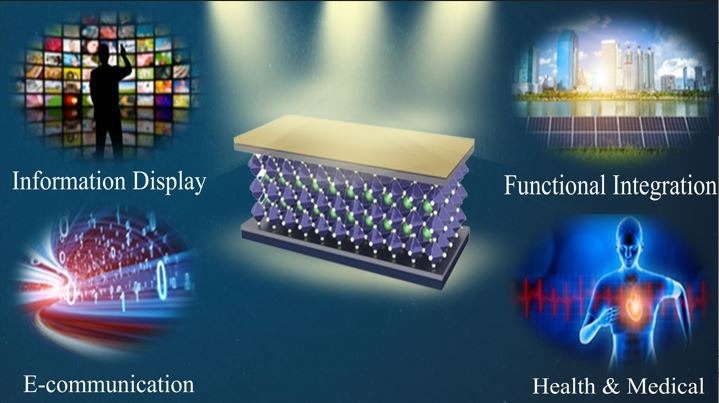Please could you introduce yourself and your professional background?
 Prof. Wei Huang is a full professor at the Institute of Flexible Electronics at Northwestern Polytechnical University. He is an academician of the Chinese Academy of Sciences, a foreign academician of the Russian Academy of Sciences, a foreign member of the ASEAN Academy of Engineering and Technology, a fellow of the Royal Society of Chemistry, and a fellow of the Optical Society of America. His research interests include polymer sciences, organic/plastic/flexible electronics, nanoelectronics, and bioelectronics.
Prof. Wei Huang is a full professor at the Institute of Flexible Electronics at Northwestern Polytechnical University. He is an academician of the Chinese Academy of Sciences, a foreign academician of the Russian Academy of Sciences, a foreign member of the ASEAN Academy of Engineering and Technology, a fellow of the Royal Society of Chemistry, and a fellow of the Optical Society of America. His research interests include polymer sciences, organic/plastic/flexible electronics, nanoelectronics, and bioelectronics.
 Dr. Chenxin Ran is an Associate Professor at the Institute of Flexible Electronics at Northwestern Polytechnical University. His research interests include photophysics characteristics of Pb/Pb-free based perovskite materials and their optoelectronic applications.
Dr. Chenxin Ran is an Associate Professor at the Institute of Flexible Electronics at Northwestern Polytechnical University. His research interests include photophysics characteristics of Pb/Pb-free based perovskite materials and their optoelectronic applications.
What are metal halide perovskites and how have they historically been applied to optoelectronic technologies?
Metal halide perovskites (MHPs) have emerged as the rising star in the field of optoelectronics over the past decade, and the state-of-the-art optoelectronic technologies based on MHPs, such as perovskite solar cells (PSCs), light emitting diodes (LEDs), photodetectors (PDs), and lasers have been leading the prevailing paradigm owing to the intriguing optoelectronic properties of MHPs. The MHP family, taking the general formula of ABX3 (A = CH3NH3+ (MA), HC(NH2)2+ (FA), and Cs+, B = Pb2+, Sn2+, X = I-, Cl-, Br-), possess the merits of facile and low-cost processing and the favorable attributes of tunable optical and electronic features, providing a rich and fertile ground for the development of high-performing multifunctional optoelectronic devices and their future industrialization.
The first study of optoelectronics with MHPs can be traced back to the 1950s; the intensely colored crystals of CsPbX3 (X=Cl, Br) with perovskite structure exhibited the behavior of a frequency-dependent photoconductive response, implying the special electrical properties of perovskites. Shortly thereafter, in the early 1990s, Mitzi and co-workers focused particular interest on the layered tin halide perovskites that are naturally self-assembled into quantum confinement structures (QWS) in the presence of alkylammonium cations, exhibiting obvious excitonic features and demonstrating potential application in LEDs and transistors.
The first observation of light emission and lasing in (C6H13NH3)2PbI4 was reported in 1998. Subsequently, with the birth of the first perovskite-sensitized solar cell with a power conversion efficiency (PCE) of 3.8% in 2009, “perovskite fever” with a focus on solar cells application achieved several milestones in PCE improvement, which has exceeded 20% since then. This breakthrough process triggered the researchers’ curiosity to explore the intrinsic optoelectronic properties of MHPs, where the adjustable band gap, long carrier diffusion length, strong light absorption, low defect density, and solution processability are identified.
In the mid-2010s, MHPs were shown to be promising for optical sources with high optical gain and stable amplified spontaneous emission (ASE), and the first laser work in the field without an external cavity as well as the first optically pumped perovskite microcavity laser were reported shortly after.

Image Credit: He Dong, Chenxin Ran, Weiyin Gao, Mingjie Li, Yingdong Xia & Wei Huang
In 2015, the first ASE and lasing in MHP nanocrystals of CsPbX3 were demonstrated with low pump thresholds. Almost at the same time, the first room-temperature perovskite LEDs were reported by Friend and co-workers. Meanwhile, the first MAPbI3 PDs with high X-ray sensitivity were investigated by Heiss and co-workers. The next evolution of MHPs in optoelectronics came from the revival of layered perovskites and perovskite nanocrystals (NCs) in the late 2010s, and they have shown competitive photoluminescence (PL) and electroluminescence (EL) efficiency compared with bulk perovskites. The EQE of green, red, and near-infrared LEDs can be as high as 20.3%, 21.3%, and 21.6%, respectively. Also, new breakthroughs in CsPbBr3 NCs X-ray detectors have been made with a low dose rate.
Propelling current interest in the 2020s is the fact that MHPs continue to exhibit new and surprising optoelectronic properties, and the certified PCE for single-junction PSCs, all-perovskite tandem solar cells, and hybrid tandem PSCs has moved up to 25.7%, 28% and 31.3%, respectively.
What is significant about the properties and structure of metal halide perovskites that make them useful in this field?
Intrinsic electronic configurations of MHPs are the direct origin of their unique optoelectronic properties, including high optical absorption, high carrier mobility, high defect tolerances, long diffusion lengths, unique ambipolar charge transport, and flexible tunability, which allows the unprecedented flexibility to independently and synergistically tune the optoelectronic properties of MHPs, laying an important foundation for MHPs being applicable to various optoelectronic applications.
You have produced a new paper on the revolutionary role of metal halide perovskites in optoelectronic systems. Why was it necessary to produce this guidance?
Metal halide perovskites (MHPs), emerging as innovative and promising semiconductor materials with prominent optoelectronic properties, have been pioneering a new era of light management (ranging from emission, absorption, and modulation, to transmission) for next-generation optoelectronic technology.
Notably, the exploration of fundamental characteristics of MHPs and their devices has been the main research theme during the past decade, while in the next decade, it will be primarily critical to promote their implantation in next-generation optoelectronics. Our paper aims to provide critical guidance to inspire the novel research direction and promote the widespread application of MHPs in optoelectronics.
Are there any limitations of metal halide perovskites that are yet to be overcome?
Despite the impressive advances of MHPs, their typical challenges, such as long-term instability and toxicity, still impede their rapid commercialization. The instability problem originates from structural degradation under certain conditions and external environments, such as moisture, oxygen, heat, light, external bias, and contact layers, which are also shown to be the origin of the instability problem of MHP-based devices.
In addition, the toxicity of perovskite materials (e.g., lead leakage) for both humans and ecosystems is also an overwhelming challenge. Future research on the safe deployment of MHP optoelectronic technology relies entirely on adopting precautionary measures against contamination at each stage of the device’s life, from fabrication to disposal/recycling, and test standards should also be established.
How will metal halide perovskites be used in optoelectronics of the future?
The application of MHPs-based optoelectronic devices in various fields has been widely investigated, including energy harvest/conversion, imaging/sensing, display/communication, and manufacturing/medicine. In these applications, MHPs exhibit superior performance compared to traditional materials, such as high efficiency, flexibility, tunability, and versatility. Taking advantage of these merits, MHPs are expected to make indispensable contributions to advanced revolutionary technologies that could benefit mankind, such as functional integration systems, information display systems, electronic communication systems, and health & medical systems.
What wider implications will this research have for the optics and photonics fields?
MHPs-based optoelectronics is a highly cross-integrated and disruptive discipline and research direction, which makes MHPs possible for meeting the high-standard requirements of commercial applications. Predictably, the development of integrated optoelectronic devices based on MHPs will have wide application prospects for the optics and photonics fields.
What are the next steps for this research?
As the rising star in the field of optoelectronics, MHPs with extraordinary properties have experienced unprecedented rapid development during the past decade. Nevertheless, to promote the large-scale utilization of MHPs, there are still many technique problems to be overcome, such as the instability and toxicity of perovskites. Notably, vast investments are required to establish the building of MHPs-based optoelectronics, and our team also makes great efforts to push the large-scale commercialization of MHPs. Overall, one can expect that in the next decade, MHPs will be under the spotlight in the era of “light”.
More from AZoOptics: Recent Developments in Optical Semiconductors
Where can readers find more information?
Our work is available at: https://doi.org/10.1186/s43593-022-00033-z
About Prof. Wei Huang and Dr. Chenxin Ran
Prof. Wei Huang is a full professor at the Institute of Flexible Electronics at Northwestern Polytechnical University. He is an academician of the Chinese Academy of Sciences, a foreign academician of the Russian Academy of Sciences, a foreign member of the ASEAN Academy of Engineering and Technology, a fellow of the Royal Society of Chemistry, and a fellow of the Optical Society of America. His research interests include polymer sciences, organic/plastic/flexible electronics, nanoelectronics, and bioelectronics.
Dr. Chenxin Ran is an Associate Professor at the Institute of Flexible Electronics at Northwestern Polytechnical University, the office manager of the Xi'an Key Laboratory of Flexible Electronics, and the member of Chinese Chemical Society and Shaanxi Flexible Electronics Society. He received his Ph.D. degree from the School of Electronic and Information Engineering at Xi’an Jiaotong University in 2016. He was a visiting scholar at Case Western Reserve University. His research interests include photophysics characteristics of Pb/Pb-free based perovskite materials and their optoelectronic applications.
Disclaimer: The views expressed here are those of the interviewee and do not necessarily represent the views of AZoM.com Limited (T/A) AZoNetwork, the owner and operator of this website. This disclaimer forms part of the Terms and Conditions of use of this website.